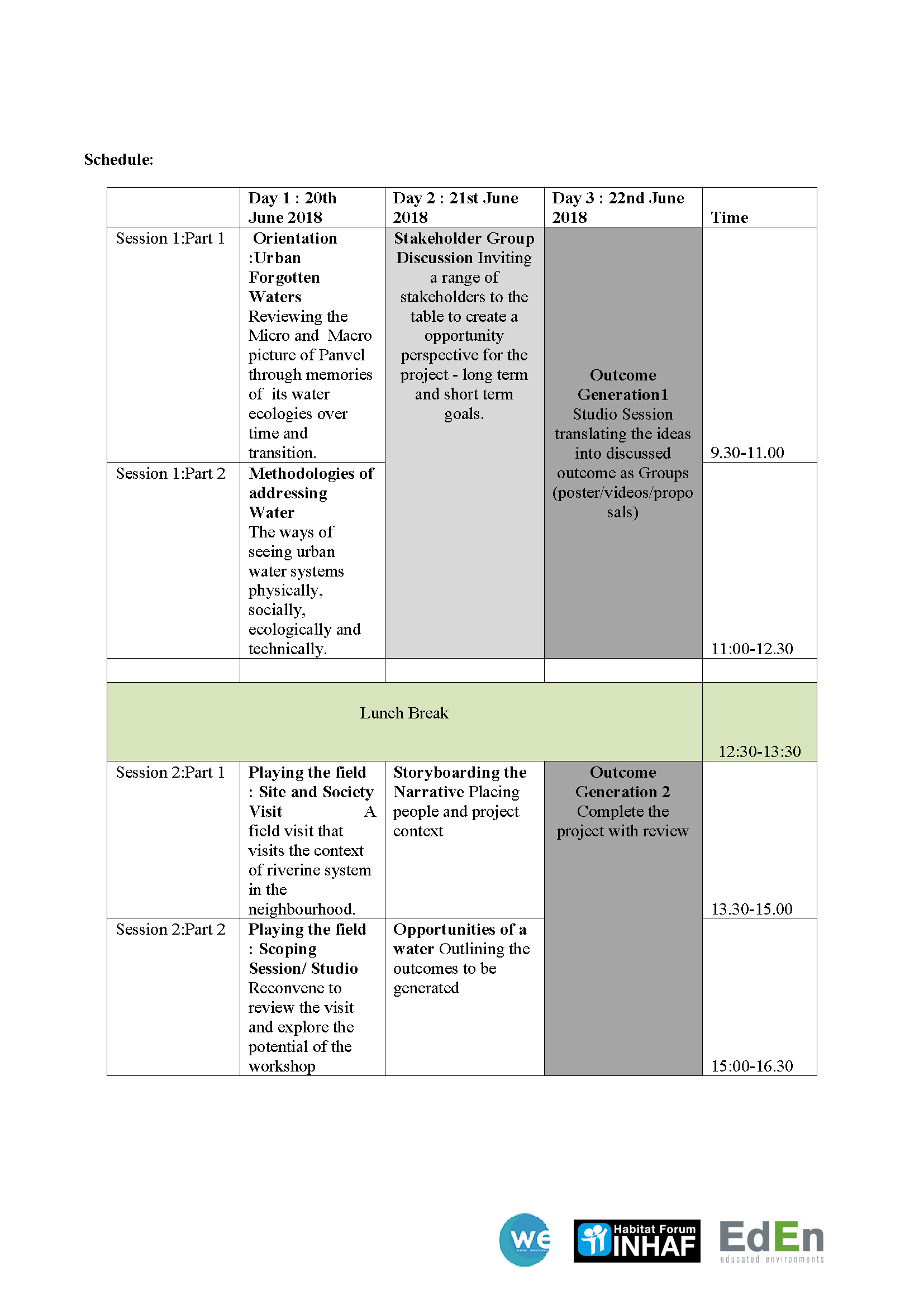The Water Story
A workshop exploring the life of urban waters

Workshop Conductors: Mr Ajay Nayak, Mr Vikram Pawar and Ms Kimaya Keluskar
Intent:
The Water Environs team has been exploring Mumbai’s rivers …yes surprise! surprise! There are four rivers that run through this megapolis. Over the last seven years what started as an investigative walk along the Dahisar river became a peoples’ movement called River March. Over the last four years it has become a walk of more than a lakh Mumbaikars who believe in turning these backyards into front yards of the city. Today the Water Environs team realises that the “Water Story” is not just about technical harvesting of the resource but dependant on the social and cultural viewpoint of its user. Supported by INHAF (India Habitat Forum) and EdEn ( Educated Environments) it is working on developing awareness and advocacy for the case of Urban Rivers and the place of biodiversity in their environments. “The Water Story” as a workshop aims to take the participants on a macro view of the state of urban water ways and then zoom into location of their immediate neighbourhood, to search for this important resource over which the future wars might explode. The workshop will adopt the guise of a urban walks, group discussions and a design charrette to allow the participants a perspective and take away on potential solutions to the water problem through a tectonic lens of an architect /planner without ignoring the reality of the lives in, on and around the rivers.
Workshop conducted at Pillai’s College of Architecture from 19th June, 2018 to 22nd June, 2018
The Kalundre river, tributary of river Ghadi runs adjoining the campus of Pillai college of Architecture. The river water was once a source of drinking as well as irrigation water for fields by the nearby villages. River water fishing was seen as one of the sources of livelihood till 2001. Soon with urban peripheral developments lot of housing schemes started proliferating between Sukhpur and Vichumbe villages, most of these are illegal constructions with no set demarcated plotline. The organic uninformed development has exerted an immense pressure on the ecology of the place converting Kalundre as a source of storm and waste water drain for the city. This calls for an urgent attention of architects planners and ecologist to restore the rivers pristine condition and create ways of cohesive living. Water Environs team along with a group of students engaged themselves onto a three day journey to explore Kalundre (Ghadi River)

Workshop Observations and Findings:
The workshop was intentionally kept open ended as we looked at it as an opportunity to create a connect with the river and mature it into a constant engagement for its revival and rejuvenation. The group was new and not residents from Panvel. So the intuitive reactions were missing after the long river walk we all took on the first day. Thus, orientation of the participants become important as it is necessary to make a group of young Architects/Urban Designers understand the importance of such exploration. We had a group of B-Arch as well as M-Arch students to work with. Along the work we introduced to various methods of visual mapping one has to imbibe to understand water resources and the ecologies which exist in and around it. For Example we spotted two dysfunctional wells on our way which were evidence of river water being used as source of potable water by the villagers. The peculiar location of trees in the vicinity of the well area were evidence of good ground table and rich nutrient quality of soil. Chirping of birds and sounds of insects showed sign of bio diversity which exists. The water Hyacinth was an indicator of high level of biological mass in the river water and deteriorated state of river ecology.
With visual mapping we did introduce other survey techniques and various environmental screening considerations to prepare DPR (Detailed Project Report) in related projects. The challenge in such projects is to understand the political will and ways in which the river as an entity is perceived by the executing authority, the municipal corporation. The BRIMSTOWARD departments consist of only engineer; this leaves them completely unequipped to handle a living entity. A focussed discussion on mapping and listing stakeholders with their role and responsibility becomes essential. Narrative building to enforce and reinforce the idea of river being a living entity and the pool of expertise it requires is the next crucial step. We spend two days of the workshop to build this narratives. These narratives were the medium of communication to various stakeholders to initiate the initial dialogues for river Kalundre. The groups worked with three narratives.
- Journeys of and along Kalundre
- Death of symbiosis (सहजीवन जला समाधी)
- Reconnecting to the river Kalundre
We encourage the students to use various mediums of expressing their views and messages they would like to convey to the various stakeholders. They used Hindi, Marathi and English language to connect to people across different strata of society and toil on emotional connect they could revive with the river.
Consciously the team refrained students from designing or proposing any design intervention. After working for 7 years on Dahisar river the team strongly believed in creating awareness amongst the communities and various organisational bodies to register the river as an living body. Hence the design charette is looked as third step in series of workshop once the collective narrative and action plan is prepared.
Workshop write up and Images:
Walk along Kalundre (Ghadi River)


Insightful Walk Along Kalundre


Working studio


Studio Reviews

Final Outcome:




